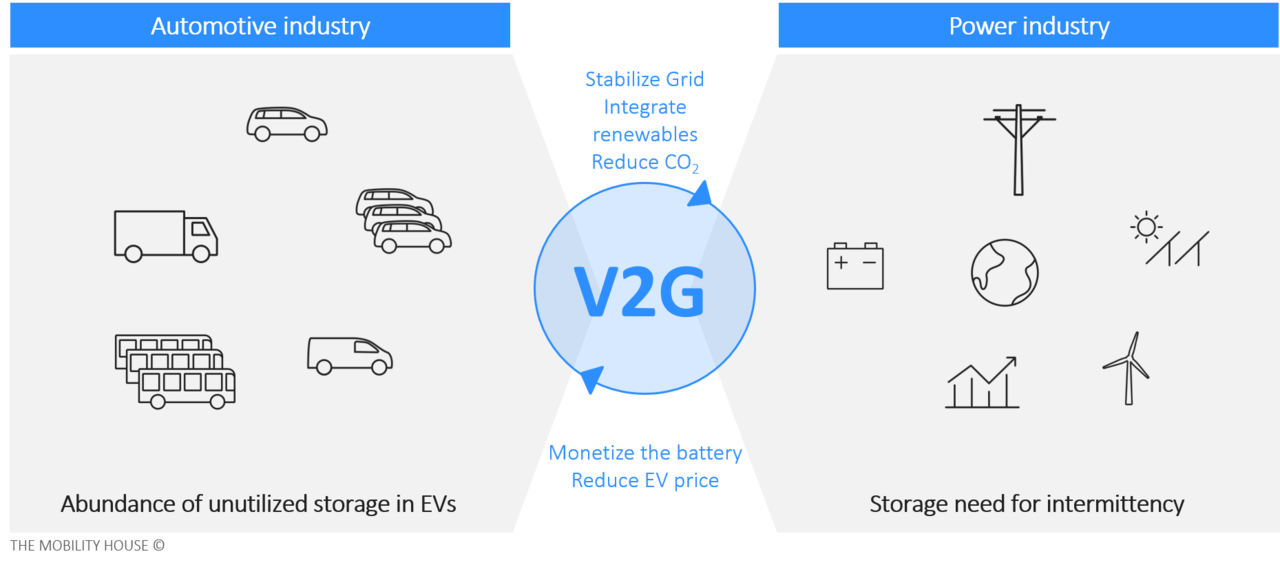The energy world of tomorrow is intelligent and sustainable. In the field of "smart grids," sector coupling has become a reality. Electric cars (EVs) play a decisive role in this. Millions of them will be on the roads in a few years. But even when they are parked, they are by no means passive: with their batteries, they form a huge swarm storage system that stabilizes the power grid and optimizes the use of renewable energies. In this way, they contribute to additional CO2 optimization in the energy system and realize completely CO2-free mobility.

The products and technologies that will make this revolution in the energy world possible are already largely developed today. Many companies from different sectors have been working intensively on this and are continuing their efforts consistently: with the common vision of an emission-free energy and mobility world in mind, car manufacturers, energy suppliers and network operators, hardware and software manufacturers from the charging infrastructure sector and technology companies are implementing intelligent and innovative solutions, creating new jobs and serving to improve the climate. A good 200 of these companies worldwide have joined forces in the Charging Interface Initiative e.V. (CharIN - www.charin.global) to work towards this goal, starting with the CCS charging system - the connection between the electric vehicle and the energy grid.
A first intermediate goal on the way to this future is the grid-serving integration of EVs into the power grid by making their charging processes controllable. For instance, the KfW subsidy program, which supports the installation of a wall box with 900 euros, therefore also stipulates that the charging point must be intelligently controllable (a set of capabilities also known as „smart charging“). A requirement that is currently met by more than 250 wall boxes of about 100 manufacturers. This diversity alone shows that EVs as energy resources which provide services to the grid have already arrived in the here and now. Thus, we don't have to fear an overloaded grid or an expensive and time-consuming expansion of grid capacities.
Michael Keller, Head of Charging Infrastructure at Volkswagen, also points to the relevance of grid-serving charging as a first interim goal:
"By being able to postpone charging of EVs to times of the day when more renewable energy capacity is available, the proportion of green electricity in electric car batteries increases."Michael Keller, Head of Charging Infrastructure at Volkswagen
Keller is clearly in favor of using attractive pricing for end customers to proactively shift charging operations so that grid operators do not have to reactively intervene when grid congestion is imminent. Keller would like to avoid such situations beforehand and therefore proposes "variable electricity tariffs" as an incentive, which is successfully operated in other countries: Those who prefer to charge at night, should be able to charge more cheaply than at peak load times. This is facilitated as electricity is available in abundance because it is renewably generated by wind turbines.
As a next step grid-serving charging should be made bidirectional: This means that EVs can also use a small amount of the energy stored in their batteries - with a correspondingly high proportion of renewable electricity - to stabilize the grid at peak, thus contributing to its stability and reliability and avoiding the operation of CO2-emitting peak load power plants. The Combined Charging System (CCS) offers the appropriate global standardized charging technology for both AC and DC.
In the first pilot projects of this innovation called Vehicle-to-Grid (V2G), EVs have already proven that they can be used to serve the grid and reduce CO2 emissions at the same time. The technology company The Mobility House was involved in several of these projects. Together with the energy supplier ENERVIE, the transmission system operator Amprion and the car manufacturer Nissan, The Mobility House already prequalified an electric car for the first time in 2018 in accordance with all regulatory requirements of the European Network of Transmission System Operators for the most demanding grid service and integrated it into the power grid as a mobile control power plant.

This is a service that grid operators generously reward, as Marcus Fendt, CSO and Managing Director of The Mobility House, explains:
"Depending on the standing time and type of vehicle, revenues of up to 650 € per year can be generated with various grid and energy services for the owner, "Marcus Fendt, CSO and Managing Director of The Mobility House
says Fendt, calculating the revenue potential. He initially sees V2G being used primarily by commercial fleets but also by solar system owners who want to increase their self-consumption.
In addition to the financial benefits for end customers, Vincent Schachter Head of Global Energy Services at ENEL X explicitly points to the practical benefits of EVs in the power grid for grid operators:
"Grid operators want a stable grid, with a higher share of renewable energies, and to control their grid investments and operations cost" Power generation from wind and solar, however, is subject to certain fluctuations, which can be balanced out with the energy from EV batteries. "And not only through primary control, to keep the grid frequency stable within seconds. But also through secondary and tertiary control, through demand response program participation, and through wholesale energy trading, in order to be able to provide balancing energy for longer periods of time."Vincent Schachter, Head of Global Energy Services at ENEL X
In principle, V2G is already in the starting blocks: hardware and software have been developed and have already proven themselves internationally in several pilot projects. What is missing is a generally applicable regulatory framework. In this respect, stakeholders expect a big push from the long-awaited publication of ISO standard 15118-20, which is scheduled for 2021 and is an essential prerequisite for scalable V2G applications. Ultimately, the new, globally valid standard will bring technological planning certainty to all players and will massively accelerate the introduction of V2G in the market.
Jörg Heuer, CEO of the charger control software company EcoG emphasizes how important ISO 15118-20 is for V2G:
"In the global vehicle market, a globally valid standard interface will very quickly bring affordable and professional solutions for end customers,"Jörg Heuer, CEO of EcoG
he predicts, as there will then also be more and more companies that want to build a business model on it.
V2G will be realized in a future-proof way with the ISO standard 15118-20 and the Combined Charging System, or CCS for short... With DC charging, the hardware required for V2G does not have to be installed in the car, as it would be the case for Type 2 plug and alternating current (AC) charging which is currently used in domestic garages and carports. With CCS, bidirectional access to the electric car or its battery takes place without a "detour" in the vehicle, directly via the charging station itself.
Jörg Heuer is already working with EcoG and some manufacturers of charging stations on corresponding DC wall boxes for V2G home use, with which an EV can also be charged and discharged at home via direct current with 11 kW or 22 kW. Upcoming DC wall boxes are expected to only be marginally more expensive than AC wall boxes, especially when considering the overall cost of ownership: as a target corridor, Heuer indicates a price range of around 2.000 €. And that's already in a good two to four years, he estimates. Hence, from industry perspective very little hurdles are in the way of introducing V2G.
However, a successful market launch also requires a free market. This is not yet the case in the highly regulated world of grid operators, energy suppliers and regulators. For example, mobile storage systems are still taxed twice as much as their stationary counterparts. When charging and when discharging. Charging at times that are beneficial to the system or CO2 emissions is also not incentivized for the customer. The respective state legislation is required to provide the appropriate framework for this new flexibility, as called for by the EU Green Deal and supported by the National Platform for Electromobility (NPM)[1] and the German Association of the Automotive Industry (VDA)[2]. In addition to helping address climate change, this will also create many local jobs and exportable innovations.
Related members
Related Downloads
NPM - Factsheet "Vehicle to Grid"– Kundennutzung und Netzintegration (pdf)
VDA - Position Rückspeisen von Elektrofahrzeugen (pdf)
News Info
Published on: 03/24/2021





